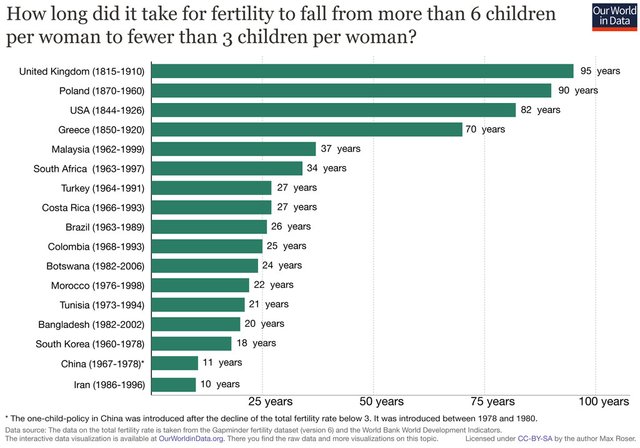The world's poor countries are stopping having children at great speed and scale.
Demography is clearly tied to the economy. For centuries, the population structure of European and Asian countries remained stable thanks to a balance, at that time, untouched: many births and many deaths. Scientific advances and the subsequent industrial revolution reversed the fate of history in Europe: deaths declined and the population, for more than a century, skyrocketed like never before.
Few countries reflected it as clearly as the United Kingdom: its population went from scarce 10 million souls at the end of the 18th century, when the industrial revolution took its first steps, at almost 40 barely a hundred years later. It was a transition boosted by a still very high birth rate, despite the drastic fall in mortality thanks to medical findings. From then on, fertility began to fall and the population, in the long term, stagnated.
Today the outlook for a large part of the European countries that followed this pattern, very long in time, is obscure: the fertility rate is in tatters and generational replacement is not guaranteed. The transition from an agrarian to an industrial economy, and later, from services, allowed women to access the education and labor system, raising the vital and temporary cost of having children. With the disappearance of the traditional female role, the high birth rate disappeared.
What is happening in the rest of the world? The above, but in a much faster time. This chart by Max Roser in Our World in Data is especially significant: while countries like Poland or the United Kingdom took more than ninety years to reduce the fertility rate by half (from six children to three per woman), others like Bangladesh or Iran has taken just one tenth (between twenty and ten years). A wild and precocious evolution.

The reasons are varied, but in general consistent with what has happened at the economic level: those changes that took years to implement in the countries that first started the transition to an industrial economy have been applied more quickly to all those who arrived after . The clearest example is China, whose transit from a farmer to a manufacturing country has set in just three decades. Others like India or Vietnam are doing it right now, and even faster.
Thanks to globalization, to a large extent, we are seeing in real time how economic change happens almost immediately to the demographic. China, for example, once the world's demographic champion, is facing an irremediable decline due to the access of large pockets of population to the middle class. The most prosperous regions of India have already experienced similar phenomena. Countries like Iran have directly gone from a permanent demographic boom to a bleak perspective similar to those of their European counterparts.

Globally, the fertility rate has fallen from 5 children per woman to 2.5, a decline set in less than a century. If before the odd thing was to run into countries where fertility had fallen below 5 children per woman, today those who are above are an exception. The few that remain are located in Africa, whose birth is still very strong: countries like Nigeria will be placed in the top three demographic of the planet before 2050. Then they will fall.
The examples of Iran and Bangladesh are interesting for one reason: when will we reach the "peak child"? The idea is known among demographic theorists and was popularized by Hans Rosling. That is, when will there stop having more children, when will we stop growing, when will the other countries reach the European state? At the moment we are very far away, but the demographic patterns of Southeast Asia put all eyes on Africa: we will arrive when their economies grow. Grow really.

In the end, it is a question of economic structure. As discussed extensively here, there are several reasons why women stop having children. Historically, access to an education and a professional perspective has represented a key aspect. When the woman left the house and entered the school her time became a precious asset, and her family role disappeared in the pursuit of individual priorities and educational choices that only the man enjoyed.
The children, moreover, stopped being interpreted as a "need" by the family nucleus. In the agrarian and older demographic models, poorer, more children involved more hands, whether for care, to collect more crops or to secure family status through other careers. A change of dilated structure in European countries, the first to undertake it, which is reproducing at the speed of vertigo in developing countries.
Hey @tamtori, great post! I enjoyed your content. Keep up the good work! It's always nice to see good content here on Steemit! Cheers :)
Hola @tamtori, upv0t3
Este es un servicio gratuito para nuevos usuarios de steemit, para apoyarlos y motivarlos a seguir generando contenido de valor para la comunidad.
<3 Este es un corazón, o un helado, tu eliges .
: )
N0. R4ND0M:
8600 1514 9013 5120
8190 7695 8323 5512
6809 9003 7978 2453
9533 7329 7371 6067